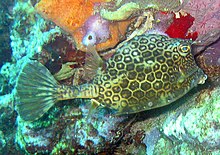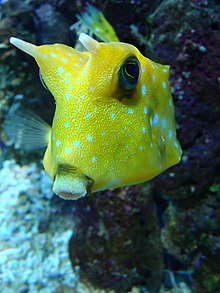Boxfish
| Boxfish | ||||||||||||
|---|---|---|---|---|---|---|---|---|---|---|---|---|

Pearl boxfish ( Lactophrys triqueter ) |
||||||||||||
| Systematics | ||||||||||||
|
||||||||||||
| Scientific name | ||||||||||||
| Ostraciidae | ||||||||||||
| Rafinesque , 1810 |
The box fish (Ostraciidae) are a family of angular-looking fish from the order of the puffer fish relatives (Tetraodontiformes). The form "Ostraciontidae" used most often in the past is wrong; etymological origin is ὀστράκιον "small (egg, mussel, clay) shell, crab shell".
features
The body of the boxfish is surrounded by a solid protective armor made of hexagonal bone plates, fused into a square housing, which is only open for the mouth, eyes, gills, fins and anus. Their shell includes the base of the dorsal and anal fin. This is not the case with the related Aracanidae . The boxfish also lack the belly edge typical of the Aracanidae. The surface of the tank can be smooth, but it can also be rough. Some species, such as the longhorn cowfish ( Lactoria cornuta ), have thorn-like horns on their foreheads and backward-pointing spines on their belly. Since the shell has grown together with the gill cover, a movement of the respiratory water via the movement of the gill cover is no longer possible. Instead, the flexible floor of the mouth takes over this function. Ventral fins and pelvic bones are missing, as are the ribs. The dorsal and anal fins have no spines, but only 9 to 13 soft rays on both fins. The caudal fin has ten primary fin rays. The number of pegs is 18 pieces. The mouth cannot be pushed forward. In each jaw they have ten teeth that have grown together to form dental plates. Boxfish are usually very colorful and have a pattern that reflects the structure of the bone shell. In many species, the sexes are colored differently.
In addition to the shell, the fish protect themselves with pahutoxin , formerly called ostracitoxin, a nerve poison that is secreted when the animals are stressed, in danger or when they die. In the limited space of aquariums, all fish, including the boxfish themselves, are killed when this poison is released.
Way of life
Boxfish live solitary or in pairs in coral reefs , algae and seaweed fields or seagrass meadows . They feed on invertebrates such as worms, tunicates or sponges , algae and seaweed . Prey hidden in the sand is exposed by blowing a jet of water. Their swimming style is ostraciiform, which means that the undulating movement of the dorsal and anal fins provide propulsion, the pectoral fins and the caudal fin are used for steering and the latter are only used as a propulsion organ during flight. They swim slowly, but are very agile and can turn on the spot.
Reproduction
Male boxfish are territorial and live with three to four females and a few young males in an area that can be 500 m². They court and spawn in the twilight on an elevated point (called rendezvous rock) of the area. Then they rise to the surface of the water and give off their gametes . There is no brood care, the eggs are pelagic and are carried away by the current. The larvae that hatch after one or two days initially also drift with the ocean currents, sometimes with their belly upwards. In some species, however, after five days as small juveniles they move on to the life of the adult animals close to the ground. Since larger larval and juvenile phases have also been found in the plankton, it is assumed that they can extend their pelagic phase if they cannot find a suitable habitat.
Systematics
In the case of boxfish, a distinction was made between two subfamilies, the originally considered Aracaninae , which occur in the waters of the West Pacific Ocean at depths of up to about 200 meters, and the Ostraciinae, which inhabit shallow, temperate and tropical seas at depths of up to 50 meters, often near coral reefs . Today, however, the Aracanidae are viewed as an independent family and the boxfish family only includes the genera and species of the former subfamily Ostraciinae.



Genera and species
- Genus Acanthostracion
- Acanthostracion guineensis ( Bleeker , 1865) .
- Acanthostracion notacanthus (Bleeker, 1863) .
- Honeycomb boxfish ( Acanthostracion polygonius ) Poey , 1876 .
- Horn boxfish ( Acanthostracion quadricornis ) ( Linnaeus , 1758) .
- Genus Lactophrys
- Black-point boxfish ( Lactophrys bicaudalis ) (Linnaeus, 1758) .
- Buffalo boxfish ( Lactophrys trigonus ) (Linnaeus, 1758) .
- Pearl boxfish ( Lactophrys triqueter ) (Linnaeus, 1758) .
- Genus Lactoria
- Longhorn boxfish ( Lactoria cornuta ) (Linnaeus, 1758) .
- Thorn boxfish ( Lactoria diaphana ) (Bloch & Schneider , 1801) .
- Backthorn boxfish ( Lactoria fornasini ) (Bianconi, 1846) .
- Lactoria paschae ( Rendahl , 1921) .
- Genus Ostracion
- Yellow-brown boxfish ( Ostracion cubicus ) Linnaeus , 1758 .
- Blue-tailed boxfish ( Ostracion cyanurus ) Rüppell , 1828 .
- Japanese boxfish ( Ostracion immaculatus ) Temminck & Schlegel , 1850 .
- White-point boxfish ( Ostracion meleagris ) Shaw, 1796 .
- Short-nosed boxfish ( Ostracion nasus ) Bloch, 1785 .
- Rhinoceros boxfish ( Ostracion rhinorhynchos ) Bleeker , 1852 .
- Striped boxfish ( Ostracion solorensis ) Bleeker, 1853 .
- Mauritius boxfish ( Ostracion trachys ) Randall, 1975 .
- White's boxfish ( Ostracion whitleyi ) Fowler, 1931 .
- Genus Paracanthostracion
- Paracanthostracion lindsayi (Phillipps, 1932) .
- Genus Tetrosomus
- Chain boxfish ( Tetrosomus concatenatus ) (Bloch, 1785) .
- Pyramidal boxfish ( Tetrosomus gibbosus ) ( Linnaeus , 1758) .
- Tetrosomus reipublicae ( Ogilby , 1913) .
- Tetrosomus stellifer (Bloch & Schneider , 1801) .
Aquaristics
Tiny boxfish, only 2 to 4 centimeters in size, are often offered in specialist shops, which people perceive as cute and which should encourage people to buy. The potential buyer should know, however, that the animals grow to be at least 30 centimeters long, eat crustaceans , molluscs and echinoderms and, after a while, destroy hard and soft corals with their strong jaws . When stressed or in the event of their death, they release their skin toxins , which kills all of the remaining fish stock.
Inspiration for technology
With their non-standard shape, boxfish are also a source of inspiration for the automotive industry. Due to its particularly low flow resistance (c w value = 0.06), the yellow-brown boxfish ( Ostracion cubicus ) served as a model for the Mercedes-Benz bionic car , a study first shown in 2005.
literature
- Joseph S. Nelson : Fishes of the World , John Wiley & Sons, 2006, ISBN 0-471-25031-7
- Kurt Fiedler: Textbook of Special Zoology, Volume II, Part 2: Fish , Gustav Fischer Verlag Jena, 1991, ISBN 3-334-00339-6
- Rudie H. Kuiter , Helmut Debelius : Atlas der Meeresfische , Kosmos-Verlag, 2006, ISBN 3-440-09562-2
- Hans A. Baensch , Robert Patzner: Mergus Sea Water Atlas Volume 6 Non-Perciformes , Mergus-Verlag, Melle, ISBN 3-88244-116-X
- Dieter Eichler, Robert F. Myers: Korallenfische Indopazifik , Jahr-Verlag GmbH & Co., 1997, ISBN 3-86132-225-0
Individual evidence
- ^ Joseph S. Nelson, Terry C. Grande, Mark VH Wilson: Fishes of the World. Wiley, Hoboken, New Jersey, 2016, ISBN 978-1118342336 . Page 521.
Web links
- Boxfish on Fishbase.org (English)